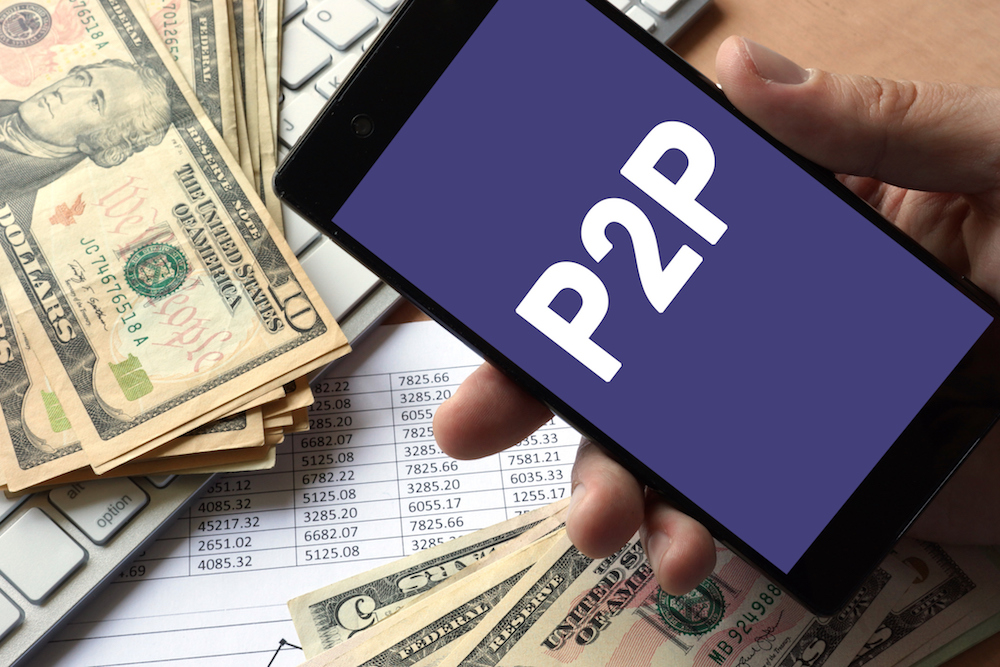Everything You Need to Know About Making Money with Peer-to-Peer Lending

The venerable Mark Ford has long preached the gospel of passive income. When you are able to secure several streams of diversified revenue and structure them all as recurring income, you’re golden.
But that doesn’t necessarily require you to build a product or service that is continually in demand. If you already have money—even a small amount—you can invest in profitable groups and clubs that are rethinking traditional investment models.
Case in point: Peer-to-peer lending.
What is peer-to-peer lending?
Here’s a basic definition from Investopedia:
Peer-to-peer (P2P) lending is a method of debt financing that enables individuals to borrow and lend money without the use of an official financial institution as an intermediary. Peer-to-peer lending removes the middleman from the process, but it also involves more time, effort, and risk than the general brick-and-mortar lending scenarios.
In this day and age, investment in traditional stocks and bonds seems more risky than promising new investment schemes. Is it any wonder that P2P lending is on the rise?
Here’s a revealing look at the P2P investment market from just a few years ago:
In the U.S., alone, P2P investors funded $6.6 billion in 2014—a 128% increase from December of 2013. Despite the U.S. P2P lending market dominating other countries in volume, the U.K. boasts a 72% larger P2P market, based on loan volume per capita.
The European P2P marketplace experienced a 144% increase, reaching nearly €3 billion ($3.9 billion) in 2014, excluding the U.K. French small business P2P loans grew nearly 4,000% the same year, with investors funding €8.2 million ($10.6 million) in small-business loans. Chinese investors anteed up 103.6 billion yuan ($16.72 billion) in 2014.
Clearly, P2P is on fire. But why? A few reasons:
- By its very definition, P2P lending circumvents banks, which have gained a bad reputation of late for gouging customers and employing corrupt lending practices.
- Any time you remove an intermediary—in this case, banks—you increase the speed of business (i.e. delivery of funds) and, more often than not, increase the returns for investors.
- Because there isn’t a bank to nab part of the interest rate profits, the interest rates themselves are often lower than what you would find at a traditional financial institution; this gets the attention of borrowers.
- The application process for a P2P loan is much simpler than anything at a big bank.
- Small-staff P2P lending companies equals more nimble processing—no extra layers of bureaucracy to wade through.
But who is P2P lending for?
Anyone. No, really. Loans range from about $1,000 to $350,000+—meeting the needs of both individuals seeking funds for personal reasons and businesses eager for development cash.
The only thing you need for a decent interest rate is a solid credit score (which a P2P lending company will check) and, for secured loans (usually personal loans of larger amounts), some kind of collateral—a valuable asset like jewelry or a vehicle.
What are the benefits to borrowers?
- Lower interest rates. 5-6% for borrowers with excellent credit scores is fairly common, while that percentage climbs to 7-35% or higher for major banks.
- As mentioned above, a streamlined process makes it easy to apply and secure loan monies quickly. A simple application and credit check usually take 24 hours (or less). It might take longer to secure funding, however, depending on the funds a P2P lending company has in-hand. It’s possible they will need to wait for investors to contribute sufficient funds—which could take anywhere from a couple of days to a couple of weeks.
- Most loans are still unsecured, meaning no collateral has to be fronted to collect loan monies.
- While credit checks are part of the process, blemishes and credit hiccups matter a bit less to P2P lenders than they do to traditional banks.
What are the benefits to investors?
- Passive income is always a good thing. As long as you meet the criteria for investing, you can earn quite a bit of money on your investment (more on that later).
- Minimum investments are low—sometimes as low $25, after an startup fund of $1,000—so you don’t need a huge bank account to start earning.
- Annual returns are close to 10% (and rising) for Prosper and LendingClub, two of the biggest P2P lending companies on the market.
- Diversification options allow investors to plug their money into different types of loans, such as personal loans, auto loans, mortgages and refinance loans, student loans, and business loans. Diversification means less overall risk.
- Investors can open an individual account, offering set returns, or retirement accounts.
What are the downsides to investing in P2P lending?
- As collateral is seldom leveraged at this point in P2P lending, investors always run the risk of borrowers defaulting on loans, leaving them with a loss of both potential interest and their original principal.
- Lending companies charge origination and annual fees; while not exorbitant, these do cut into profits.
- The Securities and Exchange Commission (SEC) has set baseline requirements for investing, including:
- A minimum $70,000 gross annual income (in most states; California’s minimum for gross annual income and net worth minimum is $85,000), as well as a net worth minimum of $70,000.)
- You must live in an approved state. Currently all states are approved for P2P investing except Arizona, New Mexico, North Carolina, Ohio and Pennsylvania.
- Net worth exception: If your net worth is at least $250,000, there is no minimum annual income requirement.
- In some cases, P2P companies will generate interest rates based on auctions. Here’s how it works: The investor suggests an interest rate to see if a borrower will take it. If not, the investor has to adjust the rate down until it is accepted. This process is clearly unpredictable, and can mean an investor settles for a much lower interest rate than originally desired. (NOTE: Many P2P companies have moved away from this model, preferring the standard rate model with set interest rates based on certain criteria. For a given set of criteria, then, the interest rates will remain the same for all borrowers until the platform changes it.)
Where do I start investing (or borrowing)?
There are four big players in the P2P lending world, each serving as a great entry point for investors and borrowers:
Before you dig into one, however, I recommend reading this article about the pros and cons of each. It will likely help you determine which one to start with based on history, reputation, loan returns, etc.
Also, be sure you examine investor guidelines in full to make sure you qualify.
Lastly, keep a sharp eye on the markets. If you have diversified your investments, be sure your dollars are aligning with profitable loans. For example, if the housing market is tanking and nobody is buying, consider moving your mortgage loan funding to something more lucrative like personal loans or student debt.
#
While P2P lending is a decade or more old, it’s now coming into its own as a more widespread investment opportunity for those tired of the ups and downs of Wall Street. With proper research, it can offer returns that blow stock market earnings out of the water—like in this case.
Just be sure you ride the wave carefully, and never put all of your P2P dollars in one pot.
Smart, profitable investors have a routine that keeps them disciplined and sharp. Many use this Morning Routine guide…
Sign up now to get our FREE Morning Routine guide—the #1 way to increase productivity, energy, and focus for profitable days. Used by thousands of fitness, business, and finance industry leaders to leapfrog the competition while making time for the people who really matter. Learn more here.
